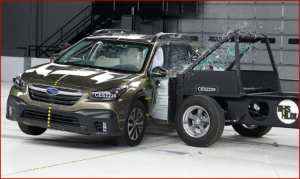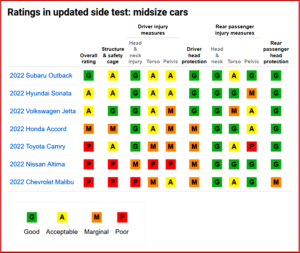
Click to enlarge. F=MA*
Only three of seven mid-size cars earn good or acceptable ratings, the Insurance Institute for Highway Safety said today as it published results of its updated side crash test. Overall, this initial group of midsize cars did not perform as well as the first batches of small and mid-size SUVs evaluated earlier. This appears to be a result of their lower ride height.
IIHS developed the updated side crash test after research showed that many of the real-world side impacts that still account for nearly a quarter of passenger vehicle occupant fatalities are more severe than the original evaluation.

F=MA. Click to Enlarge.
The updated side crash test uses a heavier barrier traveling at a higher speed to simulate the striking vehicle. The new barrier weighs 4,200 pounds – close to the weight of today’s mid-size SUVs – and strikes the test vehicle at 37 mph, compared with a 3,300-pound barrier traveling at 31 mph in the original evaluation.
*Since F=MA in Newtonian physics, the increase in weight (Mass) and speed (Acceleration) results in a substantial increase in the energy (Force) involved in such an accident.
“With vehicles that sit lower to the ground, the striking barrier hits higher on the door panel,” says IIHS President David Harkey. “That potentially puts sedans and wagons at a disadvantage in this evaluation but reflects what happens in a real-world crash when these vehicles are struck by a higher-riding pickup or SUV.”
The Subaru Outback is the only mid-size car to earn a good rating. With somewhat higher levels of occupant compartment intrusion, the Hyundai Sonata and Volkswagen Jetta manage acceptable ratings. The head-protecting airbags for the driver and rear passenger performed well in the Outback, Sonata and Jetta, contributing to a low risk of head and neck injuries for occupants in both seating positions. However, injury measures were somewhat elevated for the driver’s pelvis and rear passenger’s torso in the Jetta and the rear passenger’s pelvis in the Sonata.
The Honda Accord earns a marginal rating, and the Chevrolet Malibu, Nissan Altima and Toyota Camry earn poor ratings. There was moderate intrusion of the B-pillar into the occupant compartment of the Accord. Injury measures for the driver’s pelvis were somewhat elevated, and the driver’s head moved downward past the side curtain airbag to contact the window-sill during the crash.
The Altima and Malibu showed substantial intrusion into the occupant compartment, but the safety cage of the Camry held up well. Injury measures indicated a high risk of torso and pelvis injuries for the driver in the Altima, a moderate risk of torso and pelvis injuries for the driver and high risk of pelvis injuries for the rear passenger in the Camry, and a high risk of head or neck injuries for the driver in the Malibu. In all three vehicles, the heads of either the driver or rear passenger dummy or both slipped below the side curtain airbag to contact the window-sill.
At the moment, the updated test is not included in the IIHS award criteria. However, starting in 2023, a good or acceptable rating will be required for the lower-tier Top Safety Pick award and a good rating will be needed for the higher-tier Top Safety Pick+. All seven of these vehicles earn good ratings in the original side test.

About Ken Zino
Ken Zino, editor and publisher of AutoInformed, is a versatile auto industry participant with global experience spanning decades in print and broadcast journalism, as well as social media. He has automobile testing, marketing, public relations and communications experience. He is past president of The International Motor Press Assn, the Detroit Press Club, founding member and first President of the Automotive Press Assn. He is a member of APA, IMPA and the Midwest Automotive Press Assn.
He also brings an historical perspective while citing their contemporary relevance of the work of legendary auto writers such as Ken Purdy, Jim Dunne or Jerry Flint, or writers such as Red Smith, Mark Twain, Thomas Jefferson – all to bring perspective to a chaotic automotive universe.
Above all, decades after he first drove a car, Zino still revels in the sound of the exhaust as the throttle is blipped during a downshift and the driver’s rush that occurs when the entry, apex and exit points of a turn are smoothly and swiftly crossed. It’s the beginning of a perfect lap.
AutoInformed has an editorial philosophy that loves transportation machines of all kinds while promoting critical thinking about the future use of cars and trucks.
Zino builds AutoInformed from his background in automotive journalism starting at Hearst Publishing in New York City on Motor and MotorTech Magazines and car testing where he reviewed hundreds of vehicles in his decade-long stint as the Detroit Bureau Chief of Road & Track magazine. Zino has also worked in Europe, and Asia – now the largest automotive market in the world with China at its center.


New Side-Crash Tests: Few Mid-Size Cars Rated Good
Click to enlarge. F=MA*
Only three of seven mid-size cars earn good or acceptable ratings, the Insurance Institute for Highway Safety said today as it published results of its updated side crash test. Overall, this initial group of midsize cars did not perform as well as the first batches of small and mid-size SUVs evaluated earlier. This appears to be a result of their lower ride height.
IIHS developed the updated side crash test after research showed that many of the real-world side impacts that still account for nearly a quarter of passenger vehicle occupant fatalities are more severe than the original evaluation.
F=MA. Click to Enlarge.
The updated side crash test uses a heavier barrier traveling at a higher speed to simulate the striking vehicle. The new barrier weighs 4,200 pounds – close to the weight of today’s mid-size SUVs – and strikes the test vehicle at 37 mph, compared with a 3,300-pound barrier traveling at 31 mph in the original evaluation.
*Since F=MA in Newtonian physics, the increase in weight (Mass) and speed (Acceleration) results in a substantial increase in the energy (Force) involved in such an accident.
“With vehicles that sit lower to the ground, the striking barrier hits higher on the door panel,” says IIHS President David Harkey. “That potentially puts sedans and wagons at a disadvantage in this evaluation but reflects what happens in a real-world crash when these vehicles are struck by a higher-riding pickup or SUV.”
The Subaru Outback is the only mid-size car to earn a good rating. With somewhat higher levels of occupant compartment intrusion, the Hyundai Sonata and Volkswagen Jetta manage acceptable ratings. The head-protecting airbags for the driver and rear passenger performed well in the Outback, Sonata and Jetta, contributing to a low risk of head and neck injuries for occupants in both seating positions. However, injury measures were somewhat elevated for the driver’s pelvis and rear passenger’s torso in the Jetta and the rear passenger’s pelvis in the Sonata.
The Honda Accord earns a marginal rating, and the Chevrolet Malibu, Nissan Altima and Toyota Camry earn poor ratings. There was moderate intrusion of the B-pillar into the occupant compartment of the Accord. Injury measures for the driver’s pelvis were somewhat elevated, and the driver’s head moved downward past the side curtain airbag to contact the window-sill during the crash.
The Altima and Malibu showed substantial intrusion into the occupant compartment, but the safety cage of the Camry held up well. Injury measures indicated a high risk of torso and pelvis injuries for the driver in the Altima, a moderate risk of torso and pelvis injuries for the driver and high risk of pelvis injuries for the rear passenger in the Camry, and a high risk of head or neck injuries for the driver in the Malibu. In all three vehicles, the heads of either the driver or rear passenger dummy or both slipped below the side curtain airbag to contact the window-sill.
At the moment, the updated test is not included in the IIHS award criteria. However, starting in 2023, a good or acceptable rating will be required for the lower-tier Top Safety Pick award and a good rating will be needed for the higher-tier Top Safety Pick+. All seven of these vehicles earn good ratings in the original side test.
About Ken Zino
Ken Zino, editor and publisher of AutoInformed, is a versatile auto industry participant with global experience spanning decades in print and broadcast journalism, as well as social media. He has automobile testing, marketing, public relations and communications experience. He is past president of The International Motor Press Assn, the Detroit Press Club, founding member and first President of the Automotive Press Assn. He is a member of APA, IMPA and the Midwest Automotive Press Assn. He also brings an historical perspective while citing their contemporary relevance of the work of legendary auto writers such as Ken Purdy, Jim Dunne or Jerry Flint, or writers such as Red Smith, Mark Twain, Thomas Jefferson – all to bring perspective to a chaotic automotive universe. Above all, decades after he first drove a car, Zino still revels in the sound of the exhaust as the throttle is blipped during a downshift and the driver’s rush that occurs when the entry, apex and exit points of a turn are smoothly and swiftly crossed. It’s the beginning of a perfect lap. AutoInformed has an editorial philosophy that loves transportation machines of all kinds while promoting critical thinking about the future use of cars and trucks. Zino builds AutoInformed from his background in automotive journalism starting at Hearst Publishing in New York City on Motor and MotorTech Magazines and car testing where he reviewed hundreds of vehicles in his decade-long stint as the Detroit Bureau Chief of Road & Track magazine. Zino has also worked in Europe, and Asia – now the largest automotive market in the world with China at its center.